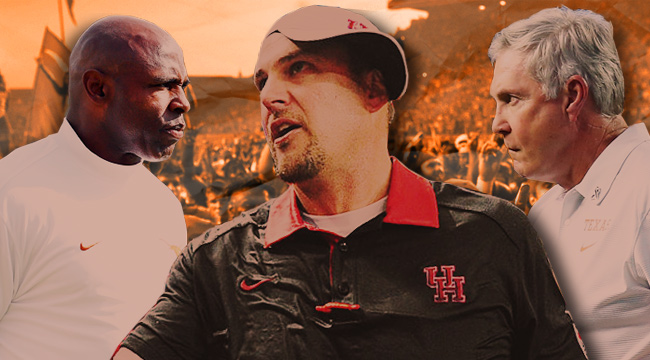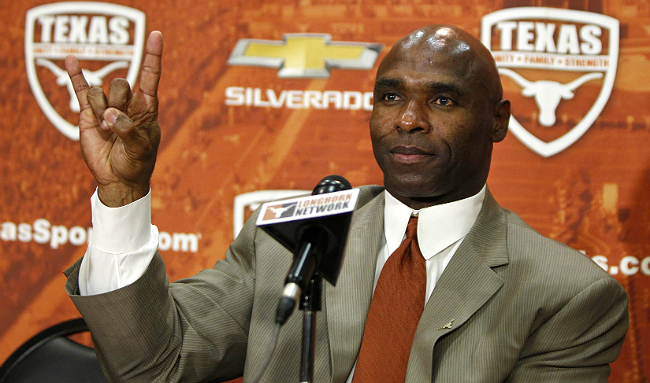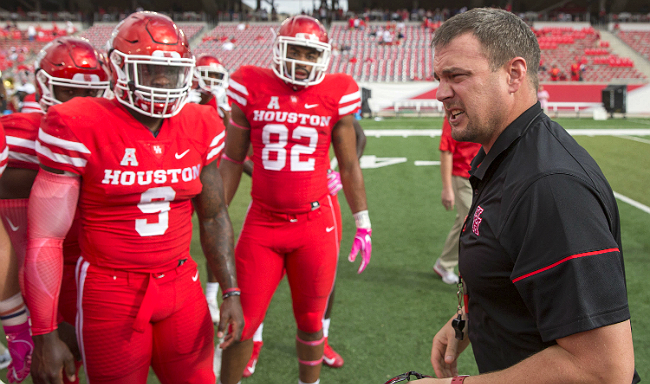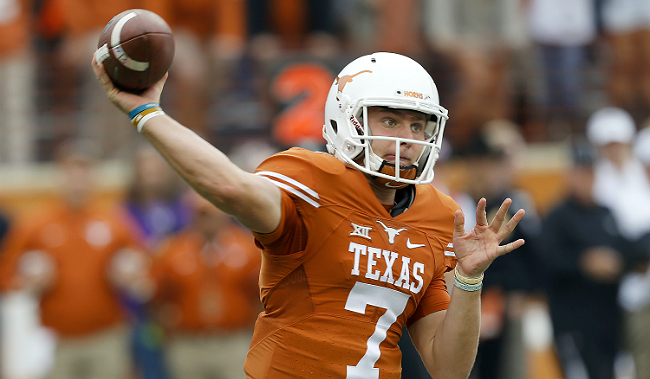
Before we get to the inevitable ascent of Tom Herman, let’s be real: Charlie Strong never stood a chance at Texas. Almost from the moment he set foot in Austin his tenure felt embattled, like a man pushing against a boulder while bystanders shook their heads in disappointment at its failure to budge.
Sure, we kept hearing, Texas fans like Charlie. Everyone so badly wanted him to succeed — just look at the outpouring of goodwill on the few occasions that he did, all of which were greeted as the beginning of a potential breakthrough. Strong’s players were with him to the bitter end. It’s just that… well… It was clear very early on that this particular marriage was not working.
For one thing, Strong always seemed like an awkward fit with the luxury-box set, less for who he was than for who he wasn’t. In 2012, a year before Strong was hired, a clique of deep-pocketed boosters impatient with the direction of the program under Mack Brown made a quixotic run at Nick Saban to replace him, and still had high hopes of landing Saban or a similarly proven, high-profile successor after they finally succeeded in forcing Brown into the talking-head business in December 2013. Instead they got Strong, whose hiring was perceived as an anticlimactic affront to the notion of Texan Exceptionalism. Billionaire donor Red McCombs, a former NFL and NBA owner whose name is on both the football stadium and the business school, became the accidental spokesman for the skeptics when he publicly described Strong’s hiring as “a kick in the face.”
“I don’t have any doubt that Charlie is a fine coach,” said McCombs, who claimed he’d personally lobbied Jon Gruden to take the job. “I think he would make a great position coach, maybe a coordinator. But I don’t believe [he belongs at] what should be one of the three most powerful university programs in the world right now at UT-Austin. I don’t think it adds up.” McCombs promptly apologized for those remarks, not least because they carried more than a faint whiff of racism. But with that kind of reception from the donor base, and with administrative turnover that claimed both the university president and the athletic director who hired Strong in the span of just a few months, it was never going to add up.
Strong bet on a long-term, tough-love approach when he kicked eight veteran players off the team prior to the 2014 campaign; instead, the subsequent 2-4 start put him on a hot seat barely halfway through his first season that, with institutional leadership divided and in flux, only kept getting hotter.

It also didn’t help that Strong had no apparent ties in Texas, or readymade connections with Texas high school coaches, the gatekeepers to the nation’s most reliable pipeline of incoming talent, especially at a moment when historical bit players within a few hours’ drive — namely Texas A&M, Baylor, and (to a lesser extent) TCU — were beginning to look like ascendant threats to the Longhorns’ grip on the best local players. The SEC was expanding its territory, as well: By the end of Strong’s second season Texas, and the Big 12 as a whole, was losing more of the state’s top prospects than it kept. The Longhorns’ roster was almost totally devoid of star power, even of the up-and-coming variety.
The personnel problems extended to Strong’s staff, which was beset by attrition (only two of the nine assistants on his original 2014 staff were still on hand for last weekend’s sendoff against TCU, both of them position coaches) and exacerbated, again, by bad timing: Rather than decisive offseason moves, Strong demoted one beleaguered coordinator only a week into the 2015 season, and another after just four games this year. The offense went through three OCs in as many seasons, and four starting quarterbacks, never developing a coherent identity. The Longhorns veered from a power-oriented philosophy to the spread option to the Air Raid and back again, eventually finishing eighth or worse in the Big 12 in scoring all three years.
So it went at Texas for Charlie Strong, a good man and probably, under most circumstances, a very good football coach. But also, with three consecutive losing seasons on his watch, the owner of the worst overall winning percentage in school history.
• • •

On paper, Herman’s résumé is almost indistinguishable from Strong’s when the latter was hired in 2013. Like Strong, he has championship experience as a coordinator under Urban Meyer, having successfully managed Ohio State’s insane quarterback situation en route to the 2014 crown. Like Strong, his first head-coaching gig was a smashing success at a mid-major outfit toiling just beneath the national radar. Herman’s two-year record at Houston (22-4) was nearly identical to Strong’s in his last two years at Louisville (23-3), right down to the upset win in a major bowl game — Peach for Herman, Sugar for Strong — that propelled them to the top of the list of candidates to fill major vacancies.
Beyond the wins and losses, though, Herman’s arrival is accompanied by a sense of forward momentum that Strong never generated, and which was frankly missing at Texas long before anyone in Austin had heard of either one of them. In part, that’s due to sheer hype: For the past year Herman has been touted by the national media, more than Strong ever was, as the heir apparent to a big-time job. (Herman was reportedly such a hot commodity last year, after just one season at Houston, that there was speculation when he opted to stay it was specifically with an eye toward the Texas gig coming open in the next cycle.) It’s also due to sheer personality: At 41, Herman is 15 years younger than Strong, hails from an up-tempo, offensive background, and has cultivated an energetic image that couldn’t be further from the straight-laced, tough-minded ethos projected by Strong.
After Strong was hired, Texas fans were reassured that he was “not a hip-hop coach,” which (implicit racial stereotypes notwithstanding) he certainly is not. Herman, on the other hand, very much is a hip-hop coach, fully capable of working Drake lyrics into a press conference and getting fitted for a diamond grill by Houston rapper Paul Wall.
Houston @CoachTomHerman with @paulwallbaby. Herman getting fitted for a grill. pic.twitter.com/XkmG7yJf0S
— Sam Khan Jr. (@skhanjr) December 15, 2015
He also makes a point to kiss each of his players on the cheek before every game, participates in panel discussions about ending sexual assault on campus, and talks openly about motivating by love rather than by fear. Houston during his tenure exploited social media as well as any program in the country. And then, yeah, plus he wins games. No wonder the media — and the web-native media, in particular — is all the way in the tank for this guy.
And no wonder that teenage recruits seem to be, too. Unlike Strong, Herman has some local ties: He began his coaching career as a graduate assistant at Texas, under Brown, and spent the next decade in the state as a small-school assistant. At Ohio State, he was largely responsible for luring Texas native J.T. Barrett to Columbus after the Longhorns passed. Within a few months of his arrival at Houston, Herman landed a stunning commitment from one of the most coveted prospects in the state, five-star defensive tackle Ed Oliver, the catalyst for a recruiting class that ultimately ranked higher than the majority of classes in the Big 12. (In his first year Oliver has already emerged as the most disruptive interior lineman in the country, to which Lamar Jackson can attest.)
At his introductory press conference on Sunday, Herman echoed Brown’s silver-tongued overtures to local prep coaches, reassuring the stewards of the “best high school football-playing state in America” that Texas “is their football program.” With a little more than two months left in the 2017 recruiting cycle, six of the state’s top 15 prospects according to 247Sports remain uncommitted and on the Longhorns’ radar.
But the momentum also stems from the sense that Herman (again, unlike Strong) will inherit a roster that is built to win right away. Among Texas fans, in fact, that’s one of the primary reasons so many of them were genuinely rooting for Strong to survive the turbulence of this season: If he could just make it to year four, the outlook for 2017 was considerably brighter than it was for any of his first three, no mater who happened to be the coach.
Instead, it’s Herman who stands to reap the rewards of the “rebuilding” phase, and if recent history is any guide the initial payoff could be the first step toward the ascendance he’s being paid to deliver. As I’ve written elsewhere, these days coaches who win big at places like Texas tend to win fast, almost invariably within their “first term” — of the 10 head coaches who have won national championships this century, all but one of them claimed his first title within four years of his arrival, on the strength of his initial recruiting classes. (The lone exception to the rule, coincidentally: Mack Brown, who was in eighth season at UT when the Longhorns finally broke through in 2005.)
For all its struggles, Texas remains essentially an up-and-coming outfit. The starting lineup in Saturday’s loss to TCU included just four seniors, and only one really notable departure: 2,000-yard tailback D’onta Foreman, who decided he’d rather get paid for next year’s workload after logging more carries in the regular season than any other FBS back.

Otherwise, the 2017 lineup will feature this year’s starting QB, eight of the top nine receivers, four-fifths of the starting offensive line, and 17 of the top 20 tacklers on defense. The quarterback, true freshman Shane Buechele, had a weird trajectory for a rookie — he started fast, immediately winning over the fan base in UT’s opening-day upset of Notre Dame, before fading a bit down the stretch — but did a passable enough Colt McCoy impression in his first year on the job to entrench himself in a position that’s been a revolving door of disappointment for the better part of a decade. Running back Chris Warren III was 1a. in the backfield alongside Foreman in September, before the former went down with a season-ending knee injury, and when healthy offers the same workhorse potential behind a veteran line. And although there was no week-in, week-out headliner among the wide receivers, there will be at least six returning candidates legitimately vying for the distinction.
For a team that lost five games by a touchdown or less, there’s no mistaking the opportunity for a quick turnaround. And from there, who knows?
• • •
It’s easy to assume that Texas, with its history, money, and location, is a program with so many inherent advantages that once some of the initial heavy lifting is done the operation can almost be set to automatic. That was certainly the case under Mack Brown, who was perceived as being so hands-off during his run of nine consecutive 10-win seasons that he more or less pioneered the image of the big-picture, “CEO coach.”
But Texas’ place among the national elite is not a given: The Longhorns never finished in the AP Top 10 under Brown’s doomed predecessors, John Mackovic and David McWilliams, or in the Top 25 under his successor. In the end, it wasn’t even a given for Brown himself. Ultimately, each of the Longhorns’ last five head coaches has been fired or (in Brown’s case) forced out for falling short of expectations, in a sport where the expectations keep rising.
Thanks in large part to Strong’s heavy lifting, Herman is walking into situation ripe for success, in a football-mad state that somehow didn’t place a single team in the most recent AP poll for the first time in almost 20 years. The Lone Star landscape looks nothing like it did three years ago: TCU has regressed, Texas A&M has a hard-won reputation for falling apart in November, and Baylor is in shambles in the wake of a scandal that will reverberate in Waco for years. (The NCAA hasn’t intervened, but between the collapse of Baylor’s 2016 recruiting class — including four blue-chip signees who defected to Texas — and the miserable outlook for 2017, the effect on the roster is the same as if the Bears had been slapped with crippling sanctions. That, and they still have no idea who their head coach is going to be following what will likely be their sixth consecutive loss this weekend at West Virginia.) Houston won’t be joining the Big 12 any time soon, meaning it’s likely downhill from here for the Cougars.
Meanwhile, Herman has the resources, the talent, the pedigree, and the disposition to put Texas back in the position it took for granted a decade ago, and the expectations to match.
What he doesn’t have is time. Texas has done the “rebuilding” thing; it’s been rebuilding for seven years, pretty much from the moment Colt McCoy was knocked out of the BCS title game against Alabama. It is done rebuilding. On day one, Herman should arrive to find a foundation that, at least in terms of the depth chart, is largely built. Even if he improves on the mediocrity of the last three seasons (and it will be almost impossible not to), if the Longhorns haven’t won a championship or landed in a major bowl game within the next three years he’ll begin to feel the heat, too, multimillion-dollar buyout be damned. It comes with the territory. It’s what he signed he up for. In Herman’s profession, it’s what it means to live the dream.






